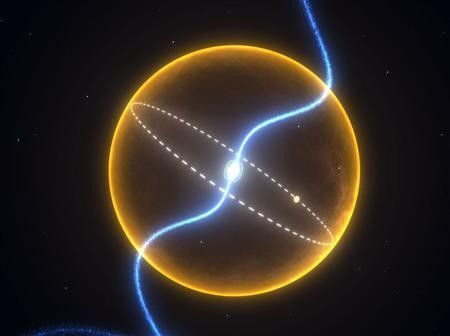Planet Made of Diamonds Discovered 4,000 Light Years Away

In what can be called a gem of a discovery, astronomers at the University of Manchester found a rare planet made of diamonds, which orbits a pulsar about 4,000 light years from Earth in the constellation Serpens.
The astronomers from Australia, Germany, Italy, the UK and the U.S. used the Parkes 64-meter radio telescope in western New South Wales to find the carbon-based planet, which is denser than any other discovered so far. A diamond forms when carbon is put under immense pressure.
As the planet largely consists of carbon, scientists speculate that the conditions are right for the carbon within it to be crystallized -- in other words, a giant celestial diamond -- and believe it to be completely made of diamond.
The diamond planet measures up to 60,000 km across, is about five time Earth's diameter and about 300 time heavier, as indicated by the astronomers' measurements.
It is believed to be the remnant of a once-massive star that lost its outer layers to the pulsar it orbits, leaving behind the crystallized core.
The Parkes radio telescope revealed a spinning star called a pulsar, which emits a beam of radio waves, said Michael Keith of CSIRO Astronomy and Space Science, and a member of the research study.
The new planet is also likely to have oxygen as well as carbon. The planet's high density suggests that lighter elements like hydrogen and helium are not present. This confluence of extraordinary factors led the researchers to believe they had stumbled across something unprecedented.
The planet is likely to be largely carbon and oxygen, because a star made of lighter elements like hydrogen and helium would be too big to fit the measured orbiting times, Keith said.
The study was led by Professor Matthew Bailes of Swinburne University of Technology in Australia and published in the journal Science.
The evolutionary history and amazing density of the planet all suggest it is comprised of carbon -- i.e. a massive diamond orbiting a neutron star every two hours in an orbit so tight it would fit inside our own sun, said Bailes.
The international research team first detected an unusual star called a pulsar, a tiny dead neutron star that spins around hundreds of times a second and emits beams of radiation.
Irregular movements in the beams gave scientists the hint that there was a companion planet orbiting the pulsar, which then led them to the diamond planet. Astronomers said only two of the 1,800 known pulsars concealed planets and it is the first diamond planet ever seen.
Researchers involved were not certain what the planet would look like up close. The astronomers believe the diamond planet is all that remains of a once massive star, but most of its matter has been siphoned off towards the pulsar it orbits.
In terms of what it would look like, I don't know I could even speculate. I don't imagine that a picture of a very shiny object is what we're looking at here,” said Ben Stappers of the University of Manchester, Reuters reported.
After finding the planet made of diamonds, will an expedition to know more about it or collect samples be planned?
It may not be possible as going into constellation Serpens, which represents the mythological serpent who revealed the secret of bringing the dead back to life, will take 4,000 light years. But let's wait till the researchers come out with close-up pictures of the diamond planet.
© Copyright IBTimes 2024. All rights reserved.





















